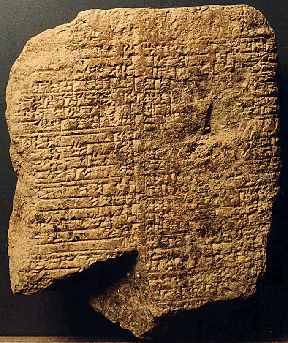Monday, May 14, 2007
Law Codes, Law Code Collections, Functions and OT

Most people when they pick up the Bible have a hard time bridging the gap between the OT and the NT. Not only does there seem to be some theological opposition but content and structure are very different too. One of the most puzzling pieces for scholars and lay people alike is the application of the OT law in light of the NT. It seems as if most if not all of the Mosaic law was subverted in the NT writings. We see Peter being told to eat unclean foods, we see Jesus working on the Sabbath. We no longer put to death those who dishonor their parents etc. The supreme theme of grace runs through the NT and seems to leave the strict legal obedience in the dust. Most of us when we think of the OT law we are trapped with thoughts of legalism, covenant fideism, cruel and unusual punishments, and boring Levitical chapter after boring Levitcal chaper. Well…just what is going on with the OT Law, is it something we can live without?
First I think we must restructure our thoughts on OT literature. Some have argued that there was a large difference between Law codes and Law code collections. The law code is the exhaustive explanation of the laws of the land/people/religion. The law code more or less is an ideal; usually in the biblical days, most people were not literate so the law code was passed on through oral traditions; and verbal proclamations etc. The Law code simply put is the law… The law code collections however are something quite different. The law code collections for the most part are samplings of the people’s laws. The law codes collections were found in very public places within the city. Since people were not believed to be able to read, why on earth were they there?
Lets look at the code of Hammurabi, one of the most famous and complete law collections ever found. The law collection itself may hint to the purpose of why it was written and on display. Hammurabi decrees to the gods that he was a just and righteous ruler, and he offers these laws as evidence to the gods that he was. The law code collection seems quite extensive (282 laws) but many say it is really incomplete and that a people could never live on these laws alone. The extensiveness of the collection is not to show the people what the laws in the city are but they stand as a testament to the gods that Hammurabi is ruling justly. There are examples of how justice was administered.
So how does this relate to the OT? Am I saying that the OT Law is incomplete? Well there are some major differences between the OT law and the other ANE laws, but also some shocking similarities. For example, in the ANE the source of the Law was from the gods, just like in
What I mean by that is this: The OT Law is not a section of Do’s and Don’ts; prescribing what should be done in each situation, but rather it is describing the holiness of God. Each law should then be taken under a process where by we could extract what is being revealed about God’s holiness.
Let me give you an example: In the OT it is stated that they are not to eat pigs (Lev. 11:7; Deut. 14:8). How does this reveal God’s holiness? Well, in biblical times it was rare to eat meat, it was very expensive and most people only ate meat at religious gatherings and sacrifices. Pigs were the most commonly used animal for sacrificing to demons. So in reality when God says don’t eat pigs, he may be saying don’t worship demons.
Even though the OT Law is descriptive it does not take away its obligatory force, in fact it strengthens it. All of the OT Law can be re-applied to any situation once the principles of God’s holiness are revealed.